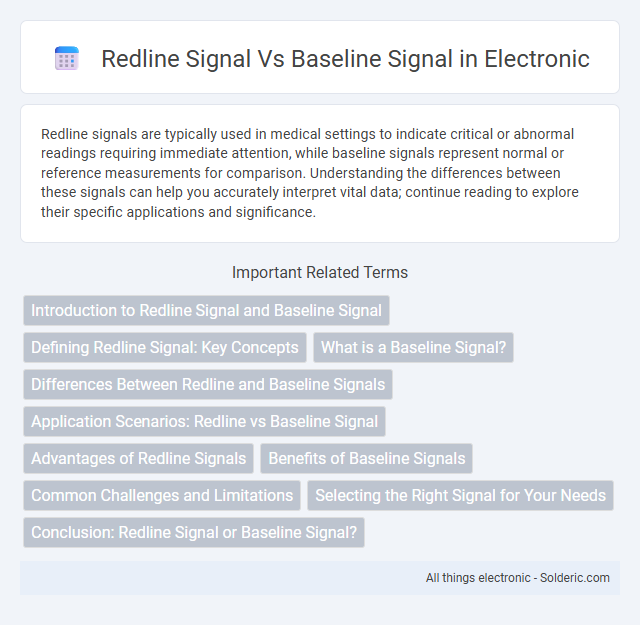Redline signals are typically used in medical settings to indicate critical or abnormal readings requiring immediate attention, while baseline signals represent normal or reference measurements for comparison. Understanding the differences between these signals can help you accurately interpret vital data; continue reading to explore their specific applications and significance.
Comparison Table
| Feature | Redline Signal | Baseline Signal |
|---|---|---|
| Definition | High-priority alert indicating critical threshold breach | Standard signal representing normal operation levels |
| Purpose | Trigger immediate action or response | Monitor routine system status |
| Signal Intensity | High intensity (urgent, pronounced) | Low to medium intensity (stable, regular) |
| Threshold Levels | Exceeds safety or performance limits | Within acceptable operational range |
| Usage Context | Critical monitoring, alarms, alerts | Baseline tracking, trend analysis |
| Response Required | Immediate investigation and corrective action | Routine monitoring, no immediate action |
Introduction to Redline Signal and Baseline Signal
Redline signal represents a critical threshold in monitoring systems, indicating maximum allowable limits beyond which system performance may degrade or failure can occur. Baseline signal serves as a reference point or standard measurement used to compare current signal readings, enabling detection of anomalies or deviations. Understanding the distinction between redline and baseline signals is essential for effective system diagnostics and preventive maintenance.
Defining Redline Signal: Key Concepts
Redline signal refers to the critical threshold in a measurement or process that indicates an immediate need for corrective action to prevent failure or damage, distinguishing it from the baseline signal, which represents normal operating conditions. This key concept helps in monitoring systems, ensuring safety, and maintaining performance by signaling when parameters exceed safe limits. Understanding redline signal thresholds allows you to implement timely interventions and avoid costly downtime or hazards.
What is a Baseline Signal?
A baseline signal represents the standard or reference measurement used for comparison in various signal processing tasks, providing a consistent benchmark to identify deviations or anomalies. It captures the normal or expected state of a system before any changes, noise, or interference affect the signal. Your ability to accurately detect differences depends on a well-defined baseline signal that ensures reliable interpretation of variations like the redline signal.
Differences Between Redline and Baseline Signals
Redline signals indicate critical or maximum thresholds exceeded in data monitoring systems, signaling urgent attention is required, whereas baseline signals represent normal operating conditions used for comparison. Redline signals typically trigger alarms or automatic responses to prevent damage or failure, while baseline signals establish a reference for detecting deviations and trends. Understanding the differences between redline and baseline signals is crucial for effective system performance monitoring and risk management.
Application Scenarios: Redline vs Baseline Signal
Redline signals excel in urgent communication scenarios such as emergency alerts and priority dispatch systems, where elevated data transmission speed and reliability are critical. Baseline signals are more suited for routine data exchanges including standard monitoring, regular updates, and non-critical system communications due to their balanced speed and bandwidth usage. Industries like public safety leverage redline signals for instant, high-priority message delivery, whereas baseline signals support ongoing operations with stable, lower-priority data flow.
Advantages of Redline Signals
Redline signals offer enhanced sensitivity and faster response times compared to baseline signals, enabling more accurate detection of critical changes in data patterns. Their improved resolution supports precise real-time monitoring, which is essential for applications requiring immediate action and high reliability. You can rely on redline signals to deliver superior performance in environments where timely and precise signal interpretation is crucial.
Benefits of Baseline Signals
Baseline signals provide a crucial reference point for detecting deviations and enhancing system accuracy. They enable efficient noise reduction and improve the reliability of anomaly detection algorithms in data analysis. By establishing standard performance metrics, baseline signals facilitate consistent monitoring and comparison over time.
Common Challenges and Limitations
Redline signals frequently face challenges such as signal interference, limited range, and susceptibility to environmental factors, which can degrade signal quality compared to baseline signals. Baseline signals, while typically more stable and standardized, may struggle with scalability issues and lack the flexibility needed for dynamic environments. Both signal types encounter limitations in noise resilience and bandwidth constraints, impacting overall communication efficiency.
Selecting the Right Signal for Your Needs
Choosing between redline signal and baseline signal involves analyzing your specific requirements for accuracy and context relevance. Redline signals often provide real-time, dynamic data ideal for high-precision applications, while baseline signals serve as stable reference points for comparative analysis. Your decision should prioritize the signal type that best aligns with your goal for reliability and responsiveness.
Conclusion: Redline Signal or Baseline Signal?
Redline signals provide critical real-time alerts that help you respond swiftly to deviations, whereas baseline signals establish standard reference points for normal system behavior. Choosing between redline and baseline signals depends on whether immediate action or ongoing system monitoring is your priority. For proactive incident management, redline signals are essential, while baseline signals support long-term performance analysis.
redline signal vs baseline signal Infographic

 solderic.com
solderic.com